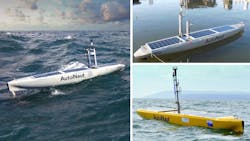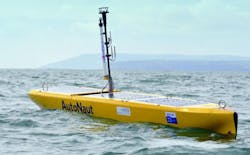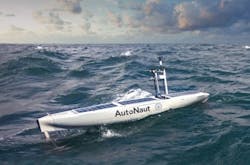Waves Propel Autonomous Boat to Enable its Ocean Monitoring Mission
An autonomous boat propelled primarily by the waves, AutoNaut, is one of the world’s first small commercial applications of wave propulsion (Fig. 1). It can operate at sea for many weeks at a time, covering hundreds of kilometers in a week in areas and conditions too hazardous for humans.
1. The AutoNaut autonomous research boat monitors sea conditions.
Built by AutoNaut Ltd., headquartered in West Sussex U.K., this autonomous boat development was supported by the ESA (European Space Agency) Business Incubation Centre Harwell in the UK. ESA’s stated mission is to inspire and facilitate use of space technology, systems, services, and know-how for non-space applications. Active in 16 countries, it connects and enables European business and entrepreneurs through:
- Business incubation for space-connected start-ups
- Brokering commercial transfers of space technology
- IP management and promotion
When it is on its research mission, a remote control workstation (RCW) controls the boat’s operations. The workstation has a graphical user interface that enables an operator to drag and drop sets of waypoints and send a command to an unmanned surface vessel (USV) anywhere in the world. From the same screen it can turn on sensors and payloads, monitor current draw, and manually set the electronic trips that protect sensitive equipment. The system includes joystick control for use at short ranges, which is useful for motoring to and from a slipway and during recovery at sea. It can carry cutting-edge, solar-powered sensors to capture raw measurements, process the data onboard, and then send them back to the operator via satellite.
AutoNaut’s family of foil-driven USVs range in length from 2 m to 7 m. The boat’s foils convert the vertical motion caused by waves lifting a boat up out of the water and dropping it down again into forward thrust. The foils are 3D printed from Nylon 12 using a selective laser sintering process, which enables the company to make intricate, detailed parts.
In refining the hydrodynamic design of the foils, AutoNaut sought to balance robustness, efficiency, and simplicity rather than maximizing efficiency, an approach that likely would have resulted in foils that were complex and fragile. Foil and hull shapes were developed together as they must work as a single system, with efforts focused on fitness for purpose rather than perfection in any single aspect.
Thrust is transferred to the hull through the foil axles attached to vertical struts that in turn attach to stainless steel fixtures at the bow and stern of the hull, which also incorporate lifting hoops. The stern strut also supports the rudder and an auxiliary electric propulsion pod; a second rudder is sometimes fitted to the bow strut.
Rock and Roll
Removable bow and stern cones protect the strut fixtures. Its foils are like wings that work in combination with a hull designed for wave propulsion. The hull shape curves upward from the keel toward the bow and the stern so that if placed on a flat surface it could easily be made to rock back and forth in pitch. Likewise, a hull with sides that curve up from the keel toward the gunwales (top edge of the side of a boat) will naturally roll from side-to-side in response to any disturbance. Both are important for generating thrust from wave motion. The AutoNaut boat is so quiet it can measure the whistles and clicks of dolphins over large areas.
AutoNaut hulls are made from a monolithic (single-skin) composite laminate of glass and aramid-reinforced polyester, the aramid element being two layers of Kevlar 49. This fabric exhibits a combination of high tensile strength and good impact resistance.
Calm wave conditions pose the only real issue for wave propulsion. When wave power is not enough, solar panels charge its batteries and power its navigation, communications, and payload systems; the steering; and an auxiliary electric thruster.
AutoNaut has an optional electric propulsion pod that can drive it at up to 3 knots for short periods. The propulsion pod consists of a brushless electric motor and a propeller in a waterproof housing that attaches to the stern strut. The device was designed mostly for use in calm wave conditions to ensure they can avoid obstructions such as oil rigs. Use of auxiliary propulsion is the RCW operator’s decision
With undulations that almost always occur at sea AutoNaut will travel at about half a knot. The highest speed achieved so far is 4 knots with a 5 m size AutoNaut.
Several factors affect the range of hull sizes that are offered. One is the ability to achieve sufficient speed to cope with tides and currents, where long, narrow hulls would tend to be faster. Other factors are the weight and volume requirements of the payload and the surface area available for the solar panels needed to run the payload and charge the batteries for driving the electric thruster.
Solar Panels
Soliban SunPower flexible solar panels intended for marine environments are used in the AutoNaut to provide electrical power for the boats’ payload. The panels use SunPower monocrystalline silicon solar cells that are said to achieve 23% conversion efficiency from sunlight to electric power. They are laminated onto modular backing panels that are bolted to the deck (Fig. 2).
2. Solar panels are mounted on the deck of the AutoNaut.
The 5 m AutoNaut has three Soliban SP panels rated at 100 W peak power. Along with the panels are charge controllers and marine lead-acid gel batteries. In this case battery weight helps because it is used as ballast. Some AutoNaut versions employ lithium-iron batteries because of their higher energy density. AutoNaut has also used an Efoy methanol fuel cell as a supplementary energy source.
A power generation controller monitors all sources and loads, and provides electronic trips and control for individual supplies. This arrangement enables the RCW operator to keep track of the charge systems, batteries, and supply channels while providing autonomous protection against surges and short-circuits.
Command and control software for the RCW’s autopilot interface is in “native” code that runs on its ARM processors. A MicroSpectre single-board autopilot has an integral MEMS gyro-stabilized magnetic compass and accepts a wide range of communications protocols, such as NMEA 0183 and standard communications.
Using satellite networks, the AutoNaut receives its instructions from anywhere in the world. The standard communications installation includes narrowband and broadband links, both Satcom and terrestrial, for local and global operations. A UHF radio is an alternative means of doing this, while Iridium RUDICS modems are embedded in the enclosures with command and control hardware. The Iridium satellite constellation provides voice and data coverage to satellite phones, pagers, and integrated transceivers over the Earth’s entire surface. The Iridium Router-Based Unrestricted Digital Internetworking Connectivity Solutions (RUDICS) is an enhanced data service that allows users who have requirements for large data transfers to do so via reliable, affordable, multi-protocol Mobile Originated (MO) and Mobile Terminated (MT) circuit switched data connectivity across the Iridium satellite network.
AutoNaut also offers a 5 GHz Wi-Fi link alongside these systems for point-to-point data offload at about 100 Mbit/s over longer ranges and sensor data offload over global range at about 150 kbit/s using Inmarsat’s Fleet Broadband Satcom service. Inmarsat plc is a British satellite telecommunications company, offering global mobile services. It provides telephone and data services to users worldwide, via portable or mobile terminals which communicate with ground stations through 13 geostationary telecommunications satellites.
Previous Missions
AutoNaut has already taken part in a number of missions with the Royal Navy, the National Oceanographic Centre, the UK Met Office, and offshore engineering industries. “AutoNaut is revolutionary and will help us to better understand our environment at a fraction of the cost of manned technologies,” said Company Director David Maclean.
About the Author

Sam Davis
Sam Davis was the editor-in-chief of Power Electronics Technology magazine and website that is now part of Electronic Design. He has 18 years experience in electronic engineering design and management, six years in public relations and 25 years as a trade press editor. He holds a BSEE from Case-Western Reserve University, and did graduate work at the same school and UCLA. Sam was the editor for PCIM, the predecessor to Power Electronics Technology, from 1984 to 2004. His engineering experience includes circuit and system design for Litton Systems, Bunker-Ramo, Rocketdyne, and Clevite Corporation.. Design tasks included analog circuits, display systems, power supplies, underwater ordnance systems, and test systems. He also served as a program manager for a Litton Systems Navy program.
Sam is the author of Computer Data Displays, a book published by Prentice-Hall in the U.S. and Japan in 1969. He is also a recipient of the Jesse Neal Award for trade press editorial excellence, and has one patent for naval ship construction that simplifies electronic system integration.
You can also check out his Power Electronics blog.




